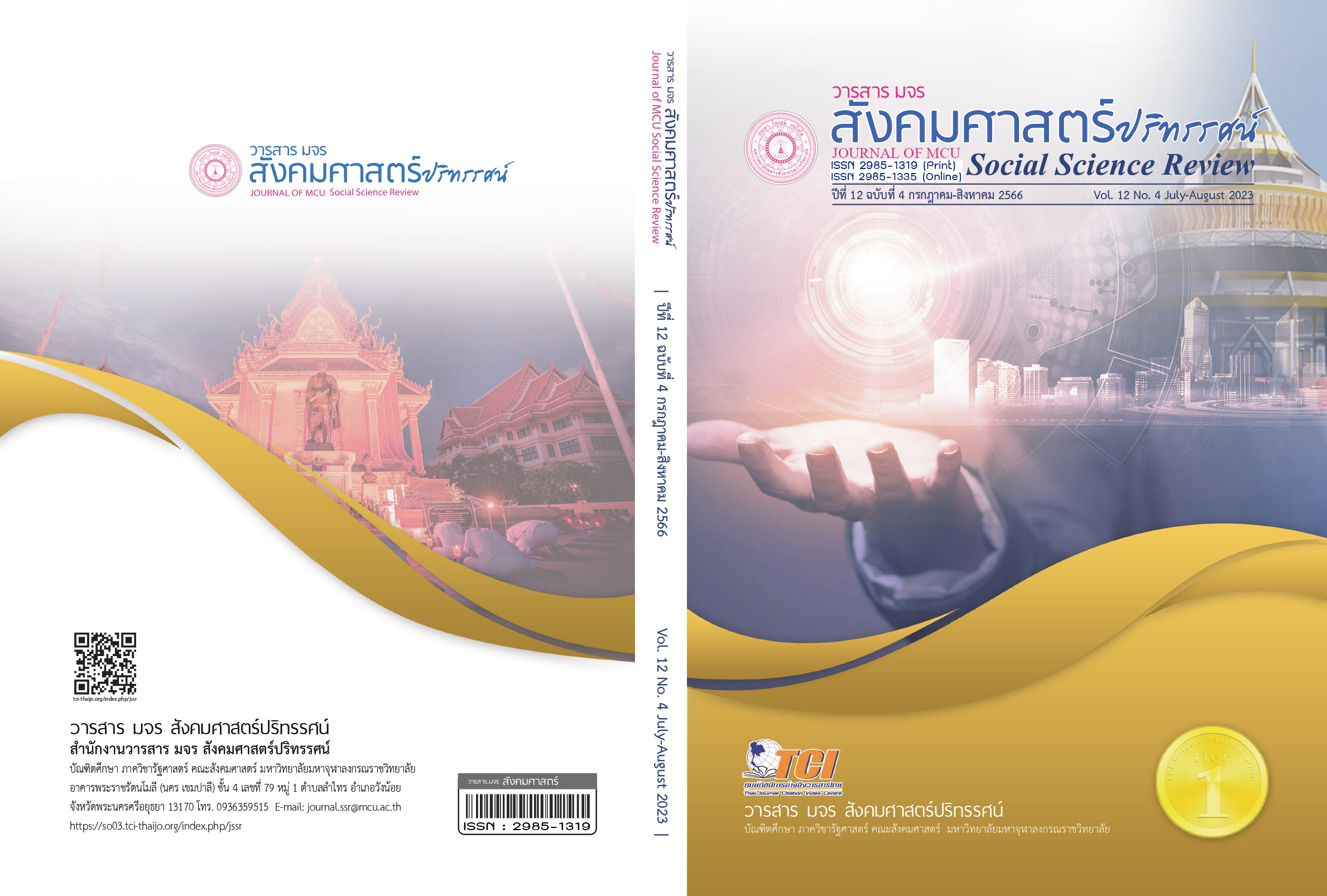ความเมตตากรุณาในนิทานไทยเรื่อง ด้วยรักบันดาล นิทานสีขาว พ.ศ 2550-2551 และ นิทานเมียนมาเรื่อง Khint Thit Pone Pyin พ.ศ 2550-2553: กลวิธีการเล่าเรื่องและแนวคิดเชิงสังคม
คำสำคัญ:
ความเมตตากรุณา, แนวคิดเชิงสังคม, กลวิธีการเล่าเรื่อง, นิทานไทย, นิทานเมียนมาบทคัดย่อ
บทความนี้เป็นการวิจัยเชิงคุณภาพ มีวัตถุประสงค์คือ 1. เพื่อศึกษาความเมตตากรุณาและแนวคิดเชิงสังคม และ 2. เพื่อศึกษากลวิธีการเล่าเรื่อง โดยใช้ข้อมูลนิทานไทยเรื่อง ด้วยรักบันดาล นิทานสีขาว ของ อาจองชุมสาย ณ อยุธยา พ.ศ 2550-2551 และนิทานเมียนมาเรื่อง Khint Thit Pone Pyin ของ Kaung Thant พ.ศ 2550-2553 โดยใช้แนวคิดความเมตตากรุณาและกลวิธีการเล่าเรื่อง
ผลการศึกษาทั้งนิทานไทยและเมียนมาพบความเมตตากรุณาที่มนุษย์มีต่อมนุษย์ มนุษย์กับสัตว์ และสัตว์กับสัตว์ ส่วนแนวคิดเชิงสังคมคือ การให้ความสำคัญของครอบครัวและญาติพี่น้อง การเป็นผู้มีอำนาจที่ปกครองด้วยคุณธรรมจริยธรรม และคนที่มีเมตตากรุณาจะได้รับผลดี ส่วนกลวิธีการเล่าเรื่อง การตั้งชื่อเรื่องแสดงให้เห็นแนวคิดสำคัญของเรื่อง แก่นเรื่องคือ ความเมตตากรุณาจะนำพาความสงบสุขมาให้ และเหมาะสมกับทุกชนชั้น ในด้านตัวละครทั้งไทยและเมียนมานิยมใช้การสร้างตัวละครตามอุดมคติ ส่วนนิทาน เมียนมาพบการสร้างตัวละครแบบสมจริง บทสนทนาของนิทานไทยทำหน้าที่ในการถ่ายทอดลักษณะนิสัยของตัวละคร
เอกสารอ้างอิง
กรรณิกา ศรีเจริญ. (2525). วิเคราะห์คุณธรรมในหนังสือการ์ตูนเล่มละบาท. บรรณศาสตร์, 5(2), 40-66.
กฤษตยา ณ หนองคาย. (2544). การศึกษาวิเคราะห์วรรณกรรมสำหรับเด็กก่อนวัยรุ่นที่ได้รับรางวัล ตั้งแต่ปี พ.ศ. 2522-2542 (วิทยานิพนธ์ปริญญาอักษรศาสตรมหาบัณฑิต.สาขาวิชาภาษาไทย). กรุงเทพฯ: จุฬาลงกรณ์มหาวิทยาลัย.
กิ่งแก้ว อัตถากร. (2519). วรรณกรรมจากบ้านใน. กรุงเทพฯ: กรมการฝึกหัดครู.
จุฑามาศ สุขขำจรูญ. (2549). การวิเคราะห์วรรณกรรมสำหรับเด็กของ ส. พุ่มสุวรรณ (สารนิพนธ์การศึกษามหาบัณฑิต สาขาภาษาไทย). กรุงเทพฯ: มหาวิทยาลัยศรีนครินทรวิโรฒ.
ฉันทนา เย็นนาน. (2539). การศึกษาวิเคราะห์นิทานพื้นบ้านภาคกลาง. (ปริญญานิพนธ์การศึกษามหาบัณฑิต สาขาภาษาไทย). กรุงเทพฯ: มหาวิทยาลัยศรีนครินทรวิโรฒ.
เฉลิม มากนวล (2518). การวิเคราะห์และเปรียบเทียบนิทานชาดกกับนนิทานอีสป. กรุงเทพฯ: กรมการฝึกหัดครู.
อาจอง ชุมสาย ณ อยุธยา. (2550). ด้วยรักบันดาล...นิทานสีขาว (เล่ม 1). กรุงเทพฯ: ฟรีมายด์.
_____. (2550). ด้วยรักบันดาล...นิทานสีขาว (เล่ม 2). กรุงเทพฯ: ฟรีมายด์.
_____. (2551). ด้วยรักบันดาล....นิทานสีขาว (เล่ม 3). กรุงเทพฯ: ฟรีมายด์.
_____. (2551). ด้วยรักบันดาล....นิทานสีขาว (เล่ม 4). กรุงเทพฯ: ฟรีมายด์.
ธนัญชย์ ชัยวุฒิมากร และบุปผา บุญทิพย์. (2559). แนวคิดคุณธรรมในนิทานสมัยใหม่:ด้วยรัก บันดาล...นิทานสีขาว ของอาจอง ชุมสาย ณ อยุธยา. วารสารวิชาการบัณฑิตวิทยาลัยสวนดุสิต, 12(2), 149-166.
มัทนา ขุนศรี และคณะ. (2564). นิทานพื้นบ้านไทยและเมียนมา: การศึกษาเปรียบเทียบกลวิธีการเล่าเรื่องและกฎเกณฑ์นิทานพื้นบ้านของเอกเซลโอลริค. พิฆเนศวร์สาร, 17(1), 28-36.
วราคม ทีสุกะ. (2528). ความคิดทางสังคมและทฤษฎีทางสังคมวิทยา. กรุงเทพฯ : สร้างสรรค์.
Kaung Thant. (2550). Khint Thit Pone Pyin (เล่ม 1). Yangon: Kaung Thant Sapay.
_____. (2551). Khint Thit Pone Pyin (เล่ม 2). Yangon: Kaung Thant Sapay.
_____. (2552). Khint Thit Pone Pyin (เล่ม 3). Yangon: Kaung Thant Sapay.
_____. (2553). Khint Thit Pone Pyin (เล่ม 4). Yangon: Kaung Thant Sapay.
_____. (2553). Khint Thit Pone Pyin (เล่ม 5). Yangon: Kaung Thant Sapay.
ดาวน์โหลด
เผยแพร่แล้ว
รูปแบบการอ้างอิง
ฉบับ
ประเภทบทความ
สัญญาอนุญาต
ลิขสิทธิ์ (c) 2023 วารสาร มจร สังคมศาสตร์ปริทรรศน์

อนุญาตภายใต้เงื่อนไข Creative Commons Attribution-NonCommercial-NoDerivatives 4.0 International License.
เพื่อให้เป็นไปตามกฎหมายลิขสิทธิ์ ผู้นิพนธ์ทุกท่านต้องลงลายมือชื่อในแบบฟอร์มใบมอบลิขสิทธิ์บทความให้แก่วารสารฯ พร้อมกับบทความต้นฉบับที่ได้แก้ไขครั้งสุดท้าย นอกจากนี้ ผู้นิพนธ์ทุกท่านต้องยืนยันว่าบทความต้นฉบับที่ส่งมาตีพิมพ์นั้น ได้ส่งมาตีพิมพ์เฉพาะในวารสาร มจร สังคมศาสตร์ปริทรรศน์ เพียงแห่งเดียวเท่านั้น หากมีการใช้ภาพหรือตารางหรือเนื้อหาอื่นๆ ของผู้นิพนธ์อื่นที่ปรากฏในสิ่งตีพิมพ์อื่นมาแล้ว ผู้นิพนธ์ต้องขออนุญาตเจ้าของลิขสิทธิ์ก่อน พร้อมทั้งแสดงหนังสือที่ได้รับการยินยอมต่อบรรณาธิการ ก่อนที่บทความจะได้รับการตีพิมพ์ หากไม่เป็นไปตามข้อกำหนดเบื้องต้น ทางวารสารจะถอดบทความของท่านออกโดยไม่มีข้อยกเว้นใดๆ ทั้งสิ้น





